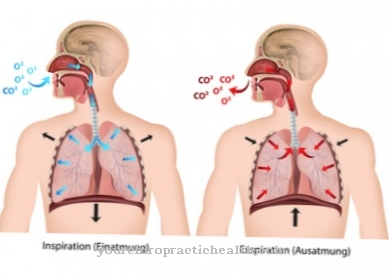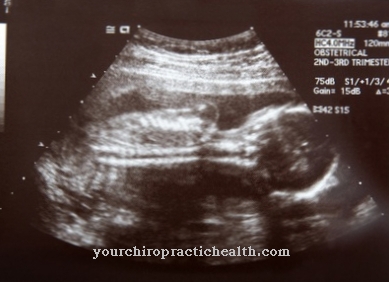Of the genotype is the entirety of all genes in the cell nucleus. Based on their arrangement, processes in the body are initiated and body compartments such as organs and external features are formed. The causes of many diseases are also hidden in the genotype.
What is the genotype?

The genes of the genotype are located on the 46 chromosomes of the human cell. The entire set of chromosomes that the individual has inherited from his or her parents is counted as a genotype. Previously, in meiosis, the double sets of chromosomes in the parents were halved. For this reason, the zygote, the emerging life, in turn inherits a double set of chromosomes, as a halved chromosome is passed on from the parent generation.
On the one hand, genes are responsible for the development of a phenotype, which manifests itself in features of the physical appearance as well as in the internal structure of the body. On the other hand, they carry the information for many different processes in the human organism. The genotype is nothing less than a microscopic imprint of the living being. For this reason it is also called biological fingerprint designated.
Function & task
The genes determine the biological process in the human and animal organism. They are based on specific base chains that are arranged in a double helix structure. The bases that make up the genes include adenine and thymine, as well as guanine and cytosine. Adenine supplements thymine and guanine docks to cytosine on the opposing DNA strands that contain the genes and jointly support the double helix.
Man is a eukaryotic organism. This means that its genetic material is enclosed in a cell nucleus and is protected by it. In prokaryotic organisms, the DNA strands are located in the cell plasma and swim through the organism.
All metabolic processes start at the genetic level. As part of its genetic predisposition, the body is able to produce metabolic products and to react to external influences. Messenger substances in the human organism read the genetic material like a data carrier and use this data to initiate processes such as protein production or the formation of individual enzymes. In addition, the genetic material determines certain characteristics of the body such as size, appearance or the functionality of organs. These traits are developed during ontogeny and body growth due to genetic predisposition.
The genes are first recombined during sexual intercourse and subsequent fertilization of the egg cell, so that the zygote receives a unique gene complex. The recombination of the genotypes of the parent generation ensures a high variability and flexibility of the population.
Thanks to mechanisms such as recombination and mutation, an arbitrary change in the genome, evolutionary advantages can arise. In this way, the gene pool of a population is, as it were, updated. This favors the adaptability of organisms to the constantly changing environmental influences. Species with a high adaptability have an increased chance in the struggle for survival.
Therefore, the composition of the genotype has proven to be a fundamental condition for the survival of an individual and his or her success in reproduction. However, effective changes in the gene pool of a species take place in periods of time that a human life cannot cover. That is why humans can only determine large-scale mutations retrospectively today. In epigenetics, however, small-scale gene changes can also be detected in the course of a person's life.
It is undeniable that the human success story over the past millennia can be traced back to a high degree of adaptability and happy mutations of genetic material.
Illnesses & ailments
Genetic predispositions therefore determine many aspects of human life from the outset. While some people have an exceptionally good disposition, others suffer from faulty or inadequate predispositions in their genetic make-up. In today's research it is believed that the majority of diseases originate from genetic material. For example, allergies and intolerances are largely hereditary. A weak immune system can also have genetic causes.
People with a high susceptibility to lung diseases or colds often have relatives with the same susceptibility. In many families there are more symptoms. For example, anyone who has several relatives who are or have had heart disease also shows an increased risk of potential heart disease. It is the same with the many different types of diseases that belong to the group of carcinogenic diseases. The risk of cancer seems to be able to pass from one parent to the child. A young woman who has many cases of breast cancer in the family is at a significantly higher risk of developing it than a person without any cancer in the family.
With other diseases, the so-called hereditary diseases, not only a risk is inherited. Since the diseases are coded by specific sections on the chromosomes, they can be passed on in their entirety to the generation of children. The best-known hereditary diseases include Wilson's disease, albinism and cystic fibrosis. Trisomy 21, also known as Down's syndrome, is a specialty among the hereditary diseases. Here the zygote receives three instead of the usual two chromosomes of the 21st chromosome pair.
The revelation of the genotype and the recording of its data sequence has brought about an advance in diagnostics. Nowadays, prenatal diagnostics can be used to calculate the risk of disease in an embryo for many pathological phenomena. Increasingly, this means that prophylactic measures can be taken. Unfortunately, the discovery of the risk of many diseases does not coincide with strategies to combat them. Nevertheless, knowledge of the genotype helps to localize responsible, faulty areas and thus to research the origins of the disease.













.jpg)

.jpg)
.jpg)











.jpg)